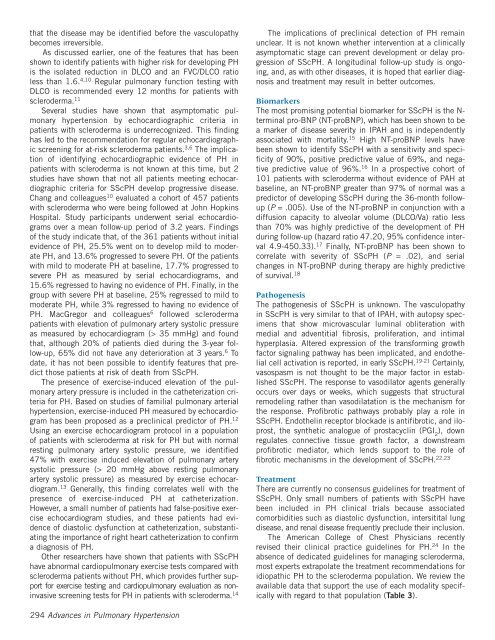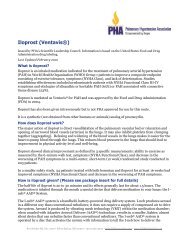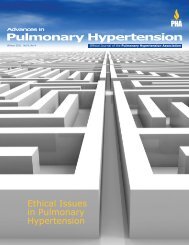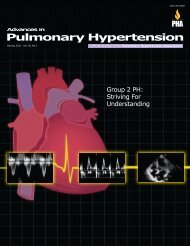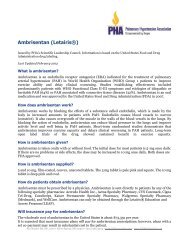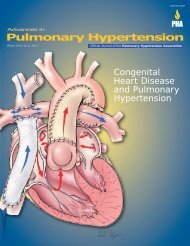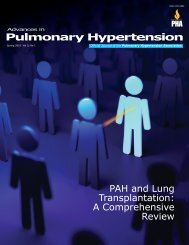Pulmonary Hypertension - PHA Online University
Pulmonary Hypertension - PHA Online University
Pulmonary Hypertension - PHA Online University
Create successful ePaper yourself
Turn your PDF publications into a flip-book with our unique Google optimized e-Paper software.
that the disease may be identified before the vasculopathybecomes irreversible.As discussed earlier, one of the features that has beenshown to identify patients with higher risk for developing PHis the isolated reduction in DLCO and an FVC/DLCO ratioless than 1.6. 4,10 Regular pulmonary function testing withDLCO is recommended every 12 months for patients withscleroderma. 11Several studies have shown that asymptomatic pulmonaryhypertension by echocardiographic criteria inpatients with scleroderma is underrecognized. This findinghas led to the recommendation for regular echocardiographicscreening for at-risk scleroderma patients. 3,6 The implicationof identifying echocardiographic evidence of PH inpatients with scleroderma is not known at this time, but 2studies have shown that not all patients meeting echocardiographiccriteria for SScPH develop progressive disease.Chang and colleagues 10 evaluated a cohort of 457 patientswith scleroderma who were being followed at John HopkinsHospital. Study participants underwent serial echocardiogramsover a mean follow-up period of 3.2 years. Findingsof the study indicate that, of the 361 patients without initialevidence of PH, 25.5% went on to develop mild to moderatePH, and 13.6% progressed to severe PH. Of the patientswith mild to moderate PH at baseline, 17.7% progressed tosevere PH as measured by serial echocardiograms, and15.6% regressed to having no evidence of PH. Finally, in thegroup with severe PH at baseline, 25% regressed to mild tomoderate PH, while 3% regressed to having no evidence ofPH. MacGregor and colleagues 6 followed sclerodermapatients with elevation of pulmonary artery systolic pressureas measured by echocardiogram (> 35 mmHg) and foundthat, although 20% of patients died during the 3-year follow-up,65% did not have any deterioration at 3 years. 6 Todate, it has not been possible to identify features that predictthose patients at risk of death from SScPH.The presence of exercise-induced elevation of the pulmonaryartery pressure is included in the catheterization criteriafor PH. Based on studies of familial pulmonary arterialhypertension, exercise-induced PH measured by echocardiogramhas been proposed as a preclinical predictor of PH. 12Using an exercise echocardiogram protocol in a populationof patients with scleroderma at risk for PH but with normalresting pulmonary artery systolic pressure, we identified47% with exercise induced elevation of pulmonary arterysystolic pressure (> 20 mmHg above resting pulmonaryartery systolic pressure) as measured by exercise echocardiogram.13 Generally, this finding correlates well with thepresence of exercise-induced PH at catheterization.However, a small number of patients had false-positive exerciseechocardiogram studies, and these patients had evidenceof diastolic dysfunction at catheterization, substantiatingthe importance of right heart catheterization to confirma diagnosis of PH.Other researchers have shown that patients with SScPHhave abnormal cardiopulmonary exercise tests compared withscleroderma patients without PH, which provides further supportfor exercise testing and cardiopulmonary evaluation as noninvasivescreening tests for PH in patients with scleroderma. 14The implications of preclinical detection of PH remainunclear. It is not known whether intervention at a clinicallyasymptomatic stage can prevent development or delay progressionof SScPH. A longitudinal follow-up study is ongoing,and, as with other diseases, it is hoped that earlier diagnosisand treatment may result in better outcomes.BiomarkersThe most promising potential biomarker for SScPH is the N-terminal pro-BNP (NT-proBNP), which has been shown to bea marker of disease severity in IPAH and is independentlyassociated with mortality. 15 High NT-proBNP levels havebeen shown to identify SScPH with a sensitivity and specificityof 90%, positive predictive value of 69%, and negativepredictive value of 96%. 16 In a prospective cohort of101 patients with scleroderma without evidence of PAH atbaseline, an NT-proBNP greater than 97% of normal was apredictor of developing SScPH during the 36-month followup(P = .005). Use of the NT-proBNP in conjunction with adiffusion capacity to alveolar volume (DLCO/Va) ratio lessthan 70% was highly predictive of the development of PHduring follow-up (hazard ratio 47.20, 95% confidence interval4.9-450.33). 17 Finally, NT-proBNP has been shown tocorrelate with severity of SScPH (P = .02), and serialchanges in NT-proBNP during therapy are highly predictiveof survival. 18PathogenesisThe pathogenesis of SScPH is unknown. The vasculopathyin SScPH is very similar to that of IPAH, with autopsy specimensthat show microvascular luminal obliteration withmedial and adventitial fibrosis, proliferation, and intimalhyperplasia. Altered expression of the transforming growthfactor signaling pathway has been implicated, and endothelialcell activation is reported, in early SScPH. 19-21 Certainly,vasospasm is not thought to be the major factor in establishedSScPH. The response to vasodilator agents generallyoccurs over days or weeks, which suggests that structuralremodeling rather than vasodilatation is the mechanism forthe response. Profibrotic pathways probably play a role inSScPH. Endothelin receptor blockade is antifibrotic, and iloprost,the synthetic analogue of prostacyclin (PGI 2), downregulates connective tissue growth factor, a downstreamprofibrotic mediator, which lends support to the role offibrotic mechanisms in the development of SScPH. 22,23TreatmentThere are currently no consensus guidelines for treatment ofSScPH. Only small numbers of patients with SScPH havebeen included in PH clinical trials because associatedcomorbidities such as diastolic dysfunction, intersitital lungdisease, and renal disease frequently preclude their inclusion.The American College of Chest Physicians recentlyrevised their clinical practice guidelines for PH. 24 In theabsence of dedicated guidelines for managing scleroderma,most experts extrapolate the treatment recommendations foridiopathic PH to the scleroderma population. We review theavailable data that support the use of each modality specificallywith regard to that population (Table 3).294 Advances in <strong>Pulmonary</strong> <strong>Hypertension</strong>


